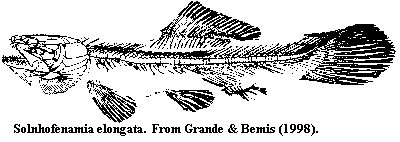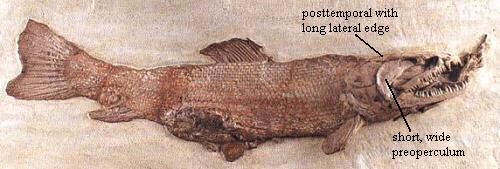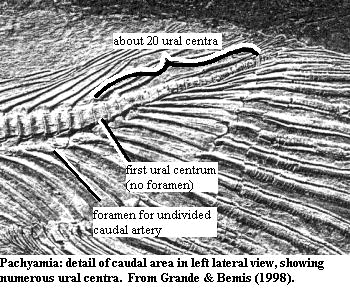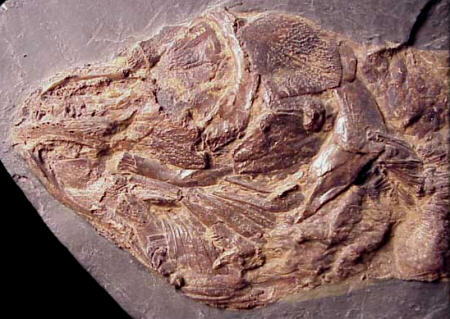 Amiidae: Nipponamia
Amiidae: Nipponamia| Neopterygii | ||
| The Vertebrates | Amiidae |
| Vertebrates Home | Vertebrate | Vertebrate |
|
Abbreviated Dendrogram
Teleostomi
├─Sarcopterygii
└─Neopterygii
├─Ginglymodi
│ ├─Macrosemiiformes
│ └─Lepisosteiformes
└─Halecostomi
├─Halecomorphi
│ ├─Parasemionotidae
│ └─Amiiformes
│ ├─Sinamiidae
│ └─Amiidae
│ ├─Amiopsis
│ └─┬─Solnhofenamia
│ └─┬─Vidalamiinae
│ └─Amiinae
└─┬─┬─Semionotiformes
│ └─Pycnodontiformes
└─┬─Pachycormiformes
└─Teleostei
|
Contents
Overview |
 Amiidae: Nipponamia
Amiidae: Nipponamia
Range: from the Late Jurassic of North America, South America, China, Japan, Middle East, Europe, Africa.
Phylogeny: Amiiformes:: Sinamiidae + *: Amiopsis + (Solnhofenamia + Vidalamiinae + Amiinae)).
Characters: parietals paired [GB98]; $ exoccipital ventral (or proximal) processes do not reach posterior margin of occiput [GB98]; extrascapulars present as single pair [GB98]; sclerotic ring primitively present [GB98]; primitively, 1 suborbital present [GB98]; gular present as large median plate; branchiostegal rays 10-13; maximum branchiostegal expansion and hyoid depression attained with closed jaws; $ (abdominal?) vertebrae with well-developed anteriorly- projecting processes on neural & hemal arches [GB98]; primitively, parapophyses not fused to abdominal centra [GB98]; abdominal and preural caudal centra completely ossified perichordally [GB98]; fin fulcra absent [GB98]; dorsal fin base >50% length of body; about 48 dorsal rays; anal fin with ~10 proximal radials [GB98]; anal fin with 8-11 fin rays [GB98]; caudal fin with convex, rounded margin [GB98]; $ preural caudal vertebrae with solid, drum-shaped centra, including diplospondylous centra of both normal and alternating types (these terms are explained under diplospondyly) [GB98]; caudal fin short & heterocercal; caudal fin outline rounded [GB98]; 1-3 ural neural arches [GB98]; urodermals two or fewer [GB98]; approximately 1:1 ratio of caudal fin rays to hypurals [GB98]; ganoid scales absent [GB98]; swim bladder capable of respiratory function; pyloric caeca absent; marine and freshwater [GB98].
Links: The Virtual Aquarium of Virginia Tech--Bowfin; FishBase; FishBase; Schlammfische; resumes3e; Fish List, Nat. Hist. of Vertebrates, Emporia State Univ.; Partial Key to The Bowfin in Freshwaters of SC; Marineland - Freshwater Fish; Phylogenetic Relationships of Neopterygian Fishes, Inferred from ... more molecular nonsense); Characteristics of the Families of Arkansas Fishes; Bowfin Family, Amiidae; Amiidae; DNR; Les Mouches - Le site par excellence pour la pêche à la mouche; InterNevod: СЕМЕЙСТВО АМИЕВЫЕ (AMIIDAE); lecture12.
References: Grande & Bemis (1998) [GB98]. APW 040806.
Amiopsis: A. prisca Kner (1863); A. lepidota Agassiz; A. woodwardi Sauvage; A. damoni Egerton; A. dolloi Traquair.
Range: Late Jurassic to Late Cretaceous of Europe.
Phylogemy: Amiidae: (Solnhofenamia + Vidalamiinae + Amiinae)) + *.
Characters: sclerotic ring present [GB98]; some forms have flattened, carinate teeth [GB98]; length anterior to dorsal fin proportionately large probably because short dorsal fin) [GB98]; $? vertebral centra with 3+ deep lateral oval fossae [GB98] [1]; parapophyses not fused to abdominal centra [GB98]; dorsal fin with only 14-19 segmented dorsal fin radials [GB98]; 5-9 ural centra [GB98]; ural centra develop from elements both dorsal and ventral to notochord [GB98]; supraneurals numerous (15-21) [GB98]; 4-7 epurals [GB98]; hypurals not fused to ural centra [GB98]; urodermals present [GB98]; scapulocoracoid well-ossified [GB98]; dermal bone ornamentation relatively weak [GB98].
Notes: [1] The presence of lateral fossae on the centra is primitive for Amiidae, but the primitive condition is 2 fossae on each side. [2] Grande & Bemis (1998) question the monophyly of this genus, as it has no really good synapomorphies.
References: Grande & Bemis (1998) [GB98]. APW 040806.
 Solnhofenamia: S. elongata Grande & Bemis 1998 (= Urocles elongata Jordan = Megalurus elongata Agassiz).
Solnhofenamia: S. elongata Grande & Bemis 1998 (= Urocles elongata Jordan = Megalurus elongata Agassiz).
Range: Late Jurassic (Kimmeridgian to Tithonian) of Europe (Germany & France).
Phylogeny: Amiidae:: (Vidalamiinae + Amiinae) + *.
Characters: sclerotic ring present [GB98]; suborbital bone present [GB98]; $ only 1 subinfraorbital which is slender & rod-like [GB98]; $ operculum extremely wide (wider than tall) [GB98]; relatively small number of dentary teeth [GB98]; parapophyses not fused to abdominal centra [GB98]; number of supraneurals reduced (5-14) [GB98]; dorsal fin with 14-34 proximal radials and 14-34 fin radials [GB98]; centra with smooth sides [GB98]; 6-8 ural centra [GB98]; ural central develop from elements both dorsal and ventral to notochord [GB98]; hypurals not fused to ural centra [GB98]; $ numerous 12-15) caudal epaxial procurrent rays [GB98]; urodermals present [GB98]; scapulocoracoid well-ossified [GB98]; dermal bone ornamentation relatively weak [GB98].
References: Grande & Bemis (1998) [GB98]. APW 040806.
 Vidalamiinae: Calamopleurus, Maliamia, Melvius, Pachyamia, Vidalamia.
Vidalamiinae: Calamopleurus, Maliamia, Melvius, Pachyamia, Vidalamia.
Range: middle Cretaceous to Eocene of Africa & South America
Phylogeny: Amiidae::: Amiinae + *.
 Characters: includes largest known amiids (up to 2m or more) [GB98]; some forms with dermopterotic rectangular (vs. wide posteriorly & tapering anteriorly) [GB98]; $ posttemporals with lateral edge at least as long as anterior edge [GB98]; parietals longer than wide [GB98]; suborbital bones absent [GB98]; two separate articular ossifications [GB98]; $ preoperculum crescentic, short & wide (easily seen in the image at right) [GB98]; $ large marginal teeth are carinate, appearing flat & arrow-head shaped in lateral view [GB98]; number of supraneurals reduced (5-14) [GB98]; pleural ribs flatly truncated [GB98]; dorsal fin with 14-34 proximal radials and 14-34 fin radials [GB98]; 11-22 ural centra [GB98]; ural centra develop from elements both dorsal and ventral to notochord [GB98]; $ large number (12-22) of ural centra [GB98]; hypurals not fused to ural centra [GB98]; urodermals present [GB98]; scapulocoracoid well-ossified [GB98]; dermal bone ornamentation pronounced [GB98].
Characters: includes largest known amiids (up to 2m or more) [GB98]; some forms with dermopterotic rectangular (vs. wide posteriorly & tapering anteriorly) [GB98]; $ posttemporals with lateral edge at least as long as anterior edge [GB98]; parietals longer than wide [GB98]; suborbital bones absent [GB98]; two separate articular ossifications [GB98]; $ preoperculum crescentic, short & wide (easily seen in the image at right) [GB98]; $ large marginal teeth are carinate, appearing flat & arrow-head shaped in lateral view [GB98]; number of supraneurals reduced (5-14) [GB98]; pleural ribs flatly truncated [GB98]; dorsal fin with 14-34 proximal radials and 14-34 fin radials [GB98]; 11-22 ural centra [GB98]; ural centra develop from elements both dorsal and ventral to notochord [GB98]; $ large number (12-22) of ural centra [GB98]; hypurals not fused to ural centra [GB98]; urodermals present [GB98]; scapulocoracoid well-ossified [GB98]; dermal bone ornamentation pronounced [GB98].
Image: (right) Calamopleurus (Late Cretaceous of Brazil) from the Senckenberg Zentrum für Biodiversitätsforschung.
Links: FORMAÇÃO SANTANA; 209.htm; resumes3e.
References: Grande & Bemis (1998) [GB98]. APW 040806.
 Amiinae: Amia, Cyclurus, Pseudamiatus.
Amiinae: Amia, Cyclurus, Pseudamiatus.
Range: from the Late Cretaceous of North America, Europe & Asia.
Phylogeny: Amiidae::: Vidalamiinae + *.
Characters: parietals longer than wide [GB98]; $ sclerotic ring absent [GB98]; $ supraorbitals absent [GB98]; $ most dorsal free postinfraorbital elongated & as long as most ventral postinfraorbital [GB98]; suborbital bones absent [GB98]; two separate articular ossifications [GB98]; $ most abdominal centra with large, well-developed parapophyses fused to the centrum [GB98]; $ 5-11 supraneurals [GB98]; $ dorsal fin having bow-shaped distal margin, with 37+ proximal radials and 36+ fin radials [GB98]; 7-10 ural centra [GB98]; $ all ural centra except first develop only from elements ventral to notochord [GB98]; 2-5 epurals [GB98]; $ all hypurals except 1st fused to ural centra [GB98]; $ urodermals absent [GB98]; $ scapulocoracoid absent (fossils) or poorly ossified [GB98]; dermal bone ornamentation pronounced [GB98]; exclusively fresh water.
Image: Detail of Cyclurus skull from Hanman's Fossils & Mineral.
Links: Cyclurus kehreri; i>.
References: Grande & Bemis (1998) [GB98]. APW 040806.
checked APW 040806.